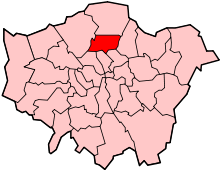Tottenham Hale
| Tottenham Hale | |
|---|---|
 Tottenham Hale Tottenham Hale shown within Greater London | |
| Population | 15,064 (2011 Census. Ward)[1] |
| OS grid reference | TQ345895 |
| • Charing Cross | 6.1 mi (9.8 km) SSW |
| London borough | |
| Ceremonial county | Greater London |
| Region | |
| Country | England |
| Sovereign state | United Kingdom |
| Post town | LONDON |
| Postcode district | N15, N17 |
| Dialling code | 020 |
| Police | Metropolitan |
| Fire | London |
| Ambulance | London |
| EU Parliament | London |
| UK Parliament | |
| London Assembly | |
Tottenham Hale is an area of northeast London and part of the London Borough of Haringey. From 1850–1965, it was part of the Municipal Borough of Tottenham, in Middlesex.
Etymology
It takes its name from the old English word Hale (to hoist or pull), as goods (particularly timber) were unloaded from the River Lea for onward transport by road at this point.
Character of the area
Centred around Tottenham Hale station the area was largely industrial in character with an emphasis on timber related products. The industrial sites have now given way to the development of large residential areas and a retail park. There is a large-scale housing project currently under construction,[2] and Haringey Council is formulating plans to redevelop the area.[3]
The east of Tottenham Hale borders the London Borough of Waltham Forest and the Walthamstow Reservoirs including the Walthamstow Wetlands. The River Lea runs through the east of Tottenham Hale. This includes the Tottenham Lock and the Pymmes Brook merging with the river. Surrounding these are a series of residential areas: Hale Village, the Ferry Lane Estate, Heron Wharf and the under construction Hale Wharf development.
Hale Village's design is based on Hammarby Sjöstad in Stockholm, Sweden.
Demography
The largest ethnic group in the 2011 census was Other White, 22%, followed by 18% White British, 16% Black African and 13% Black Caribbean.[4]
Wildlife
The nearby Walthamstow Reservoirs and River Lea support a variety of waterfowl including herons, geese, swans, moorhens and coots.
The Walthamstow Reservoirs have been awarded a Heritage Lottery grant, funding their development into Europe's largest Urban Wetland Park. This is due for completion in September 2017.
The Paddocks Nature Park provides a nesting site for birds such as song thrush, blackbird and various warblers. Weasels and hedgehogs as well as bats reside in the park.
Industry
The following companies are or have been located in the Tottenham Hale area:
| Name | Dates | Notes |
|---|---|---|
| Hale Motors/ The Ray Powell Group | Rootes/Chrysler Main Dealers, 1970s. | |
| Cannon Automotive | Makers of rubber car mats etc. | |
| Gestetner | It was formerly the location of the Gestetner duplicating machine factory, opened in 1906 and growing to be the largest duplicator manufacturer in the world, employing around 6,000 people until the 1970s. | |
| Eagle Pencils (later Berol) | 1910 to the 1990s | |
| Dickinsons Stationery | ||
| English Abrasives | Abrasive papers etc. | |
| Harris Lebus | 1904 - 1969 | At one time this was the largest furniture factory in Europe, employing 8,000 by the late 1930s. During the Second World War the factory produced parts for De Havilland Mosquito aircraft, the Airspeed Horsa attack glider and even false wooden copies of the Sherman tank.[5] The factory featured a large network of air raid shelters, which survived until the site was redeveloped in 2008 for a local mixed-use development.[6] |
| Greater London Council (GLC) Supplies Department | The site of the 29,000m2 warehouse of the former Greater London Council which provided a centralised purchasing function for the GLC, the Inner London Education Authority and some of the outer London boroughs. This warehouse was on the site of the former Harris Lebus factory on the north side of Ferry Lane and was redeveloped in 2008. | |
| Beavertown Brewery | 2014 | Craft Brewery |
| Pressure Drop | 2017 | Craft Brewery |
| Fifth Column Ltd | 2014 | T-shirt Printing |
Education
- For details of education in Tottenham Hale see the London Borough of Haringey article.
Transport
Tottenham Hale station is on the Victoria line and also has National Rail Abellio Greater Anglia services. This includes the Stansted Express, the West Anglia Main Line and the Lea Valley Lines. The station is also part of the proposed Crossrail 2 project.
The redevelopment of Tottenham Hale bus station was completed in December 2014. The railway and Underground station is currently under redevelopment. Work has begun on installing an extra National Rail track to increase the frequency of services.
The following bus routes serve the bus station: 41, 76, 123, 192, 230, W4, N41 and N73.
References
- ↑ "Haringey Ward population 2011". Neighbourhood Statistics. Office for National Statistics. Retrieved 23 October 2016.
- ↑ "Archived copy". Archived from the original on 18 June 2008. Retrieved 17 September 2008.
- ↑ Tottenham Hale Master Plan
- ↑ http://www.ukcensusdata.com/tottenham-hale-e05000281
- ↑ Hiller, N, Lebus A Brief History (http://www.harrislebus.com/lebus-a-brief-history/ accessed 21/02/2014)
- ↑ Suleman, M, Lebus Air Raid Shelters (http://www.harrislebus.com/lebus-air-raid-shelters/ accessed 21/02/2014)
Gallery
- The River Lea as it flows through Tottenham Hale and past Heron Wharf.
- The Lea passing the Ferry Lane Estate.
- The GLS Warehouse at the junction of Ferry Lane and Mill Mead Road, behind Tottenham Hale station. Now demolished.
 Demolition of the GLS Warehouse.
Demolition of the GLS Warehouse.- Heron House. Now demolished, formerly on the Hale Wharf site.
 Tottenham Hale Retail Park.
Tottenham Hale Retail Park.
